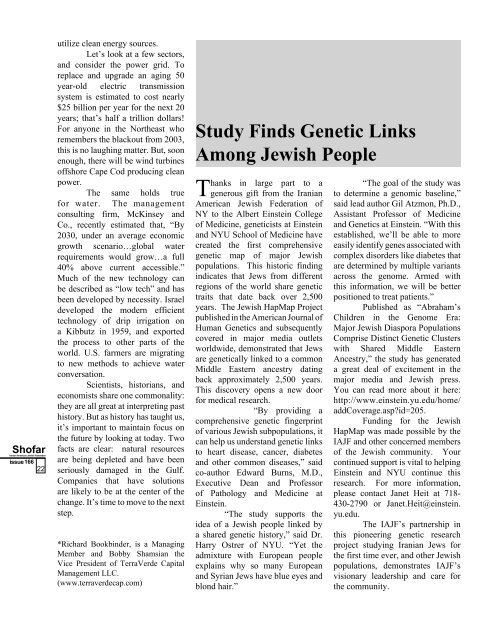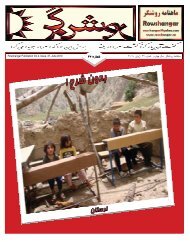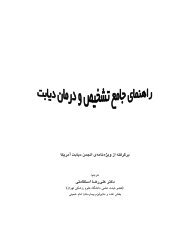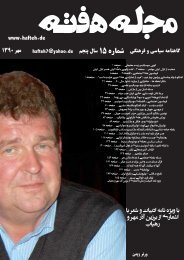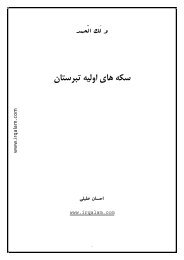166 - ketab farsi
166 - ketab farsi
166 - ketab farsi
Create successful ePaper yourself
Turn your PDF publications into a flip-book with our unique Google optimized e-Paper software.
<strong>166</strong><br />
22<br />
utilize clean energy sources.<br />
Let’s look at a few sectors,<br />
and consider the power grid. To<br />
replace and upgrade an aging 50<br />
year-old electric transmission<br />
system is estimated to cost nearly<br />
$25 billion per year for the next 20<br />
years; that’s half a trillion dollars!<br />
For anyone in the Northeast who<br />
remembers the blackout from 2003,<br />
this is no laughing matter. But, soon<br />
enough, there will be wind turbines<br />
offshore Cape Cod producing clean<br />
power.<br />
The same holds true<br />
for water. The management<br />
consulting firm, McKinsey and<br />
Co., recently estimated that, “By<br />
2030, under an average economic<br />
growth scenario…global water<br />
requirements would grow…a full<br />
40% above current accessible.”<br />
Much of the new technology can<br />
be described as “low tech” and has<br />
been developed by necessity. Israel<br />
developed the modern efficient<br />
technology of drip irrigation on<br />
a Kibbutz in 1959, and exported<br />
the process to other parts of the<br />
world. U.S. farmers are migrating<br />
to new methods to achieve water<br />
conversation.<br />
Scientists, historians, and<br />
economists share one commonality:<br />
they are all great at interpreting past<br />
history. But as history has taught us,<br />
it’s important to maintain focus on<br />
the future by looking at today. Two<br />
facts are clear: natural resources<br />
are being depleted and have been<br />
seriously damaged in the Gulf.<br />
Companies that have solutions<br />
are likely to be at the center of the<br />
change. It’s time to move to the next<br />
step.<br />
*Richard Bookbinder, is a Managing<br />
Member and Bobby Shamsian the<br />
Vice President of TerraVerde Capital<br />
Management LLC.<br />
(www.terraverdecap.com)<br />
Study Finds Genetic Links<br />
Among Jewish People<br />
Thanks in large part to a<br />
generous gift from the Iranian<br />
American Jewish Federation of<br />
NY to the Albert Einstein College<br />
of Medicine, geneticists at Einstein<br />
and NYU School of Medicine have<br />
created the first comprehensive<br />
genetic map of major Jewish<br />
populations. This historic finding<br />
indicates that Jews from different<br />
regions of the world share genetic<br />
traits that date back over 2,500<br />
years. The Jewish HapMap Project<br />
published in the American Journal of<br />
Human Genetics and subsequently<br />
covered in major media outlets<br />
worldwide, demonstrated that Jews<br />
are genetically linked to a common<br />
Middle Eastern ancestry dating<br />
back approximately 2,500 years.<br />
This discovery opens a new door<br />
for medical research.<br />
“By providing a<br />
comprehensive genetic fingerprint<br />
of various Jewish subpopulations, it<br />
can help us understand genetic links<br />
to heart disease, cancer, diabetes<br />
and other common diseases,” said<br />
co-author Edward Burns, M.D.,<br />
Executive Dean and Professor<br />
of Pathology and Medicine at<br />
Einstein.<br />
“The study supports the<br />
idea of a Jewish people linked by<br />
a shared genetic history,” said Dr.<br />
Harry Ostrer of NYU. “Yet the<br />
admixture with European people<br />
explains why so many European<br />
and Syrian Jews have blue eyes and<br />
blond hair.”<br />
“The goal of the study was<br />
to determine a genomic baseline,”<br />
said lead author Gil Atzmon, Ph.D.,<br />
Assistant Professor of Medicine<br />
and Genetics at Einstein. “With this<br />
established, we’ll be able to more<br />
easily identify genes associated with<br />
complex disorders like diabetes that<br />
are determined by multiple variants<br />
across the genome. Armed with<br />
this information, we will be better<br />
positioned to treat patients.”<br />
Published as “Abraham’s<br />
Children in the Genome Era:<br />
Major Jewish Diaspora Populations<br />
Comprise Distinct Genetic Clusters<br />
with Shared Middle Eastern<br />
Ancestry,” the study has generated<br />
a great deal of excitement in the<br />
major media and Jewish press.<br />
You can read more about it here:<br />
http://www.einstein.yu.edu/home/<br />
addCoverage.asp?id=205.<br />
Funding for the Jewish<br />
HapMap was made possible by the<br />
IAJF and other concerned members<br />
of the Jewish community. Your<br />
continued support is vital to helping<br />
Einstein and NYU continue this<br />
research. For more information,<br />
please contact Janet Heit at 718-<br />
430-2790 or Janet.Heit@einstein.<br />
yu.edu.<br />
The IAJF’s partnership in<br />
this pioneering genetic research<br />
project studying Iranian Jews for<br />
the first time ever, and other Jewish<br />
populations, demonstrates IAJF’s<br />
visionary leadership and care for<br />
the community.


